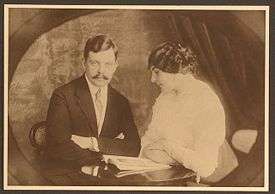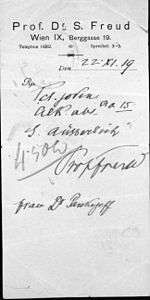Sergei Pankejeff
| Sergei Pankejeff | |
|---|---|
|
Sergei Pankejeff | |
| Born |
Панкеев Сергей Константинович December 24, 1886 Odessa |
| Died | May 7, 1979 (93 years) |
| Nationality | Russian |
Sergei Konstantinovitch Pankejeff (Russian: Серге́й Константи́нович Панке́ев; December 24, 1886 – May 7, 1979) was a Russian aristocrat from Odessa best known for being a patient of Sigmund Freud, who gave him the pseudonym of Wolf Man (der Wolfsmann) to protect his identity, after a dream Pankejeff had of a tree full of white wolves.
Biography

The Pankejeff family (note: this is Freud's German transliteration from the Russian; in English it would today be transliterated as Pankeyev) was a wealthy family in St. Petersburg. Sergei attended a grammar school in Russia but after the 1905 Russian Revolution he spent considerable time abroad studying. During his review of Freud's letters and other files, Jeffrey Moussaieff Masson uncovered notes for an unpublished paper by Freud's associate Ruth Mack Brunswick. Freud asked her to review the Pankejeff case, and she discovered evidence that Pankejeff had been sexually abused by a family member during his childhood.[1]
In 1906, his older sister Anna committed suicide while visiting the site of Mikhail Lermontov's fatal duel, and by 1907 Sergei began to show signs of serious depression himself. Sergei's father Konstantin also suffered from depression, often connected to specific political happenings of the day, and committed suicide in 1907 by consuming an excess of sleeping medication, a few months after Sergei had left for Munich to seek treatment for his own ailment. While in Munich, Pankejeff saw many doctors and stayed voluntarily at a number of elite psychiatric hospitals. In the summers he always visited Russia.
Der Wolfsmann (The Wolfman)

In January 1910, Pankejeff's physician brought him to Vienna to have treatment with Freud. Pankejeff and Freud met with each other many times between February 1910 and July 1914, and a few times thereafter, including a brief psychoanalysis in 1919. Pankejeff's "nervous problems" included his inability to have bowel movements without the assistance of an enema, as well as debilitating depression. He also felt like there was a veil cutting him off from the world. Initially, according to Freud, Pankejeff resisted opening up to full analysis, until Freud gave him a year deadline for analysis, prompting Pankejeff to give up his resistances.
Freud's first publication on the "Wolf Man" was "From the History of an Infantile Neurosis" (Aus der Geschichte einer infantilen Neurose), written at the end of 1914 but not published until 1918. Freud's treatment of Pankejeff centered on a dream the latter had as a very young child, and described to Freud as such:
- "I dreamt that it was night and that I was lying in bed. (My bed stood with its foot towards the window; in front of the window there was a row of old walnut trees. I know it was winter when I had the dream, and night-time.) Suddenly the window opened of its own accord, and I was terrified to see that some white wolves were sitting on the big walnut tree in front of the window. There were six or seven of them. The wolves were quite white, and looked more like foxes or sheep-dogs, for they had big tails like foxes and they had their ears pricked like dogs when they pay attention to something. In great terror, evidently of being eaten up by the wolves, I screamed and woke up. My nurse hurried to my bed, to see what had happened to me. It took quite a long while before I was convinced that it had only been a dream; I had had such a clear and life-like picture of the window opening and the wolves sitting on the tree. At last I grew quieter, felt as though I had escaped from some danger, and went to sleep again." (Freud 1918)
Freud's eventual analysis (along with Pankejeff's input) of the dream was that it was the result of Pankejeff having witnessed a "primal scene" — his parents having sex a tergo ("from behind" or "doggy style") — at a very young age. Later in the paper Freud posited the possibility that Pankejeff had instead witnessed copulation between animals, which was displaced to his parents.
Pankejeff's dream would play a major role in Freud's theory of psychosexual development, and along with Irma's injection (Freud's own dream, which launched dream analysis), it was one of the most important dreams for the developments of Freud's theories. Additionally, Pankejeff became the main case used by Freud to prove the validity of psychoanalysis. It was the first detailed case study not involving Freud analyzing himself which brought together the main aspects of catharsis, the unconscious, sexuality, and dream analysis put forward by Freud in his Studies on Hysteria (1895), The Interpretation of Dreams (1899), and his Three Essays on the Theory of Sexuality (1905).
Later life
Pankejeff would later publish his own work under Freud's given pseudonym, and would be in contact with Freudian disciples until his own death (undergoing analysis for six decades, despite Freud's pronouncement of his being "cured"), making him one of the longest-running famous patients in the history of psychoanalysis.
A few years after finishing psychoanalysis with Freud, Pankejeff developed a psychotic delusion. He was observed walking the streets staring at his reflection in a mirror, convinced that some sort of doctor had drilled a hole in his nose. Ruth Mack Brunswick, a Freudian, explained the delusion as displaced castration anxiety.
Criticism of Freud's interpretation
Critics, beginning with Otto Rank in 1926, have questioned the accuracy and efficacy of Freud's psychoanalytic treatment of Pankejeff.[2] Similarly, in the mid-20th Century psychiatrist Hervey Cleckley dismissed Freud's diagnosis as farfetched and entirely speculative.[3] Dorpat has suggested that Freud's behavior in the Pankejeff case as an example of gaslighting (attempting to undermine someone's perceptions of reality).[4]
Daniel Goleman, in the New York Times, wrote the following:
Freud's key intervention with the Wolf Man rested on a nightmare in which he was lying in bed and saw some white wolves sitting on a tree in front of the open window. Freud deduced that the dream symbolized a trauma: that the Wolf Man, as a toddler, had witnessed his parents having intercourse. Freud's version of the supposed trauma, however, was contradicted by the Wolf Man himself, Sergej Pankejeff, in an interview with Karin Obholzer, a journalist who tracked him down in Vienna in the 1970s.Mr. Pankejeff saw Freud's interpretation of his dream as 'terribly far-fetched.' Mr. Pankejeff said, 'The whole thing is improbable,' since in families of his milieu young children slept in their nanny's bedroom, not with their parents.
Mr. Pankejeff also disputed Freud's claim that he had been cured, and said he resented being 'propaganda' and 'a showpiece for psychoanalysis.' Mr. Pankejeff said, 'That was the theory, that Freud had cured me 100 percent.' However, 'It's all false.'
Maria Torok and Nicolas Abraham have also reinterpreted the Wolf Man's case (in The wolf man’s magic word, a cryptonymy), presenting their notion of "the crypt" and what they call “cryptonyms." They provide a different analysis of the case than Freud, whose conclusions they criticise. According to the authors, Pankejeff's statements hide other statements, while the actual content of his words can be illuminated by looking into his multi-lingual background. According to the authors, Pankejeff hid secrets concerning his older sister, and as the Wolf Man both wanted to forget and preserve these issues, he encrypted his older sister, as an idealised "other" in the heart of himself, and spoke these secrets out loud in a cryptic manner, through words hiding behind words, rebuses, wordplays etc. For example, in the Wolf Man's dream, where six or seven wolves were sitting in a tree outside his bedroom window, the expression "pack of six", a "sixter" = shiestorka: siestorka = sister, which gives the conclusion that his sister is placed in the centre of the trauma.
The case forms a central part of the second plateau of Gilles Deleuze and Félix Guattari's A Thousand Plateaus, titled "One or Several Wolves?" In it, they repeat the accusation made in Anti-Oedipus that Freudian analysis is unduly reductive and that the unconscious is actually a "machinic assemblage". They argue that wolves are a case of the pack or multiplicity and that the dream was part of a schizoid experience.
"The greatest triumph and cure Freud reported was the case of the Wolf man—Sergei Pankeev, who was crippled with depression and anxiety and phobia about wolves from childhood. Freud settled upon the traumatic effects of the so-called primal scene, when an infant witnesses his parents copulating; the Oedipus complex and the fear of castration; and the tripartition of the mind into id, ego, and superego. As is general knowledge, Freud made castration anxiety and the Oedipus complex not merely the cause of neurosis but the indispensable, universal cause of the formation of each individual’s superego, and thus the crucial factor in the repression and control of primitive impulses—and so in the preservation of civilization. Freud published the case in 1918 where he claimed to have cured Pankeev completely, freeing him of all of his fears and obsessions, however, the status of his cure is debatable. For nearly 70 years, Pankeev was in and out of analysis with Freud and his followers with his condition worsening, until Freud's death. In the 1970s, an Austrian journalist, Karin Obholzer, found him and interviewed him at length. Pankejeff told her, in despair, "the whole thing looks like a catastrophe. I am in the same state as when I came to Freud, and Freud is no more."
See also
Notes
- ↑ "Anally seduced" as Masson writes, using Freud's "seduction" as an umbrella term for sexual maltreatment. Masson, Jeffrey Moussaieff. (1984) The Assault On Truth: Freud's Suppression of The Seduction Theory. Pocket Books, 1984, 1998. ISBN 0-671-02571-6
- ↑ The Letters of Sigmund Freud and Otto Rank: Inside Psychoanalysis (eds. E. J. Lieberman and Robert Kramer). Baltimore: Johns Hopkins University Press. 2012.
- ↑ "I have become increasingly convinced that some of the popular methods presumed to discover what is in the unconscious cannot be counted upon as reliable methods of obtaining evidence. They often involve the use of symbolism and analogy in such a way that the interpreter can find virtually anything that he is looking for. Freud, for instance, from a simple dream reported by a man in his middle twenties as having occurred at 4 years of age drew remarkable conclusions. The 4-year-old boy dreamed of seeing six or seven white wolves sitting in a tree. Freud interpreted the dream in such a way as to convince himself that the patient at 18 months of age had been shocked by seeing his parents have intercourse three times in succession and that this played a major part in the extreme fear of being castrated by his father which Freud ascribed to him at 4 years of age. No objective evidence was ever offered to support this conclusion. Nor was actual fear of castration ever made to emerge into the light of consciousness despite years of analysis." Hervey Cleckley, The Mask of Sanity, 1941, fifth edition 1976, ISBN 0-9621519-0-4
- ↑ Dorpat, Theodore L. (28 October 1996). Gaslighting, the double whammy, interrogation, and other methods of covert control in psychotherapy and psychoanalysis. J. Aronson. ISBN 978-1-56821-828-1. Retrieved 16 June 2011.
References
- Whitney Davis, Drawing the Dream of the Wolves: Homosexuality, Interpretation and Freud's 'Wolf Man' (Indianapolis: Indiana University Press, 1995), ISBN 978-0-253-20988-7.
- Sigmund Freud, "From the History of an Infantile Neurosis" (1918), reprinted in Peter Gay, The Freud Reader (London: Vintage, 1995).
- James L. Rice, Freud's Russia: National Identity in the Evolution of Psychoanalysis (New Brunswick, NJ: Transaction Publishers, 1993), 94-98. ISBN 1-56000-091-0
- Torok Maria, Abraham Nicolas, The wolf man's magic word, a cryptonymy, 1986
External links
| Wikimedia Commons has media related to Sergei Pankejeff. |